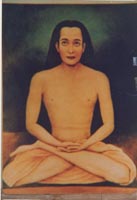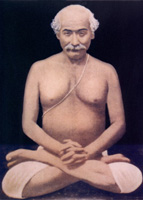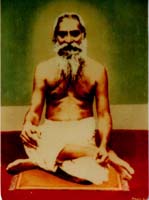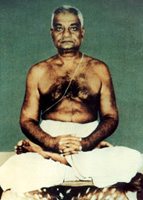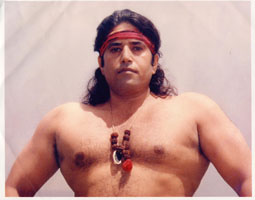Kriya yoga is an ancient practice of yoga the knowledge of which was lost in the Middle Ages and resumed in XIX century due to Babaji Maharaj. Lots of miracles, including that he defeated death, are connected with his name. Babaji appeared to Lahiri Mahasaya in the hills of Himalayas in 1861. He taught him the forgotten knowledge of kriya yoga and told to spread it all over the world. This meeting is described in the book of Paramahansa Yogananda Autobiography of a Yogi (1946).
Thus Babaji was the first guru in the lineage of kriya yoga. His disciple, Lahiri Mahasaya, passed the knowledge to his eldest son Tinkori Lahiri Mahasaya, who, in his turn, to his son Satyacharan Lahiri Mahasaya, and he – to Shailendra Sharma.
|
|
Shailendra about Kriya Yoga Practice
Kriya Yoga is an advanced form of yoga, which enables the practitioner to comprehend his own immortal substance, that is inside everybody. It will also enable him to understand the relationship between mind and body and how to develop the consciousness.
Many people say that kriya yoga is practiced to know God. But the basic theme of kriya yoga is to know yourself, all the possibilities, which are inside you, and to awaken the subconscious mind to conscious state. Only then will you begin to understand the working of Creation; and maybe you will get advanced enough to know the Creator.
Here I will give a very brief introduction of kriya yoga. I’ve read many different versions of kriya yoga from all over the world, but I will tell you only what my lineage taught me.
Kriya yoga has 11 major steps.
On the first introductory level there are 7 techniques. We begin by offering our pranam to our guru, and then we start practicing. First there are two practices for the tongue — talabya kriya and jihva chalan — they help to achieve khechary mudra. Then there is a technique called manasik pranayama — when you have to concentrate on your spine and spinal cord. Then there is shvans sahit pranayama and nabhi kriya. After that — yoni mudra, which enables you to see your immortal substance. Then maha mudra, which prepares your body for very high practices of kriya yoga that will come later. That’s it, the 7 techniques are done, and they have different proportion. They should be learned directly from your guru.
After one has achieved khechary mudra there is a reshuffle in these techniques, and the pranayama in nabhi kriya is introduced. And then some other mudras are introduced, that is called «first level with khechary mudra». After that, when the person who has gone that far and who has been practicing to the best of his ability, advances enough to receive second level of practice that is given in three levels. First is just an introduction, secondly a certain mantra is given to him, and thirdly he is taught certain head movements and certain pranayama. That is the second level. It starts to open the heart knot — hridaya granthi bheda. And it takes the body quite a long time to adjust to this practice.
So after a person has been successfully practicing the second level for some time and has mastered the pranayama in yoni mudra and in nabhi kriya, then he is advanced enough to receive the third level, which is more powerful, than the second level, and develops your mind even more. With these practices the experience in yoni mudra becomes deeper and more mystical.
When the body is fine-tuned and the nervous system is strong enough, the fourth level is given. It is a very-very strong pranayama. It takes quite a lot of time — one or two years — just to be comfortable with it. It is one of the most difficult pranayam and very few people go further.
After that the fifth level is given, and again it is a preparation for the sixth level. It also takes quite a lot of time. It is called dhyan kriya — the kriya for your mind concentration. And from here meditation, or concentration, becomes deeper and deeper. And mind becomes more refined and gives you more ability to concentrate. It will give you the ability to concentrate outside of your body and enable you to come out of your physical body consciously.
So when the fifth level is done completely, a very difficult pranayama is taught, which is called the sixth level pranayama. It opens the knot of vajra nadi, which is inside sushumna, and creates the door for kundalini to arise. I think I have read about almost every system, and there is no direct technique to activate vajra nadi, except the technique of kriya yoga.
After you had mastered these techniques, on the seventh level third pranayama of nabhi kriya is taught, which will enable you to leave your body consciously at the time of death. And that gives you enough power to come out of your physical body consciously and do whatever you want. You can do everything with this pranayama.
Up to the seventh level, is hridaya granthi bheda — it is all going around opening your heart knot.
Then eighth and ninth level are for rudra granthi bheda. And a special technique is taught, which is called omkar kriya. And then the final stage of yoni mudra is taught — that is the ninth level. After that you get a certain mantra and a technique for shambhavi mudra, which enables you to remain in samadhi in your conscious hours. Wherever you want to be, you will always remain in samadhi.
This is a brief introduction to kriya yoga. As you progress, you will learn more and more.
The beauty and power of kriya yoga is that immediately after diksha you will begin to experience your immortal substance. But seeing is one thing, and becoming friendly and intimate with your own Atma, or your own soul – is something different: it takes time. You see somebody, but it does not mean that you are great friends, suddenly simply by seeing. To become intimate with your own immortal substance requires a lot of practice. The more you see somebody, the closer you become to that person. You should be comfortable together — you and your immortal substance, and that is a rare phenomena.
So I’ve given this brief introduction just for the information for a true seeker. If he is committing himself to kriya yoga practice, he should have a very clear vision of how far he will have to go.
